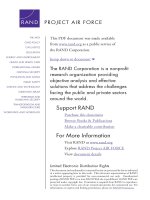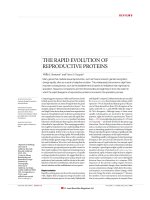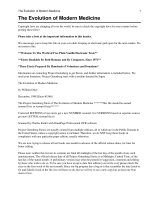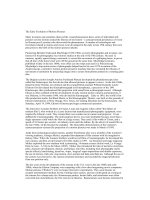The microstructural evolution of Ti-6Al-4V specimens fabricated by selective laser sintering of pre-alloyed powders
Bạn đang xem bản rút gọn của tài liệu. Xem và tải ngay bản đầy đủ của tài liệu tại đây (1.18 MB, 9 trang )
Vietnam Journal of Science and Technology 57 (3A) (2019) 103-111
doi:10.15625/2525-2518/57/3A/13941
THE MICROSTRUCTURAL EVOLUTION OF TI-6AL-4V
SPECIMENS FABRICATED BY SELECTIVE LASER SINTERING
OF PRE-ALLOYED POWDERS
Nguyen Minh Thuyet1, *, Nguyen Hoang Viet1, Jin-Chun Kim2
1
School of materials science and engineering, Hanoi University of Science and Technology,
No1, Dai Co Viet, Hai Ba Trung, Ha Noi, Viet Nam
2
School of Materials Science and Engineering University of Ulsan, 93Daehak-ro,
Nam-gu, Ulsan, 44610, Korea
*
Email:
Received: 13 July 2019; Accepted for publication: 25 September 2019
Abstract. Selective laser sintering (SLS) is known as a cutting-edge technique to manufacture
complex geometry products. Among various kinds of materials, Ti-6Al-4V is one of the most
popular materials for the SLS process. The as-built Ti-6Al-4V products were widely applied in
many applications such as aerospace, automobile, and especially in medical and implant parts.
The purpose of this research is to investigate the microstructure and other properties of Ti6Al4V
samples produced by selective laser sintering technique. Through this research, the direct
fabrication of Ti6Al4V metal object by SLS machine has been carried out using MetalSys250
machine. Different parameters of the SLS process were used to produce 1cm x1cmx1cm cubic
samples and then microstructure as well as mechanical properties of the as-built samples were
investigated. Powder particles are fully dense, possess a spherical shape and are composed of
acicular α phase. The as-built sample shows the oriented acicular martensitic phase with the
defined columnar grain structures.
Keywords: Ti-6Al-4V, 3D-printing, Selective laser sintering, Laser patterns, microstructure.
Classification numbers: 2.9.1, 2.10.1, 2.10.2.
1. INTRODUCTION
Selective laser sintering (SLS) is a type of additive manufacturing (AM) technique which
has been widely used to produce 3D objects from metal, polymer, and ceramic powders recently
[1]. It was also known as a promising manufacturing process compared to conventional methods
due to their remarkable features in term of fabricating very complicated parts even with high
melting point materials, reduce the production time, and provide good mechanical properties to
products. Therefore, the SLS has been applied in many applications such as aerospace, medical
and implant manufacturing, and many other industrial fields [2]. The SLS has become possible
to reliably manufacture dense parts for a number of materials, including steel, copper, aluminum,
and titanium. Among these materials, Ti-6Al-4V powder has been widely used for highperformance engineering solutions in aerospace motor cases, aircraft turbines, pressure vessels,
Nguyen Minh Thuyet, Nguyen Hoang Viet, Jin-Chun Kim
and marine components. Recently, many studies have invested in using SLSed Ti-6Al-4V
products for biomedical applications such as implant parts in surgery [3]. In the SLS process, the
microstructure as well as the quality of products is affected by a large number of different
process parameters [4, 5] such as laser powers, laser scanning speeds, laser scanning strategies
(pattern), laser hatches distance and layer thickness [6, 7]. Thus, one of the most interesting
advantages offered by the SLS technique is that it allows tailoring of the as-built microstructure
by accommodating the process parameters in a strategic presentation. For example, the quantity
of the energy deposited to the metallic powders, (the energy density) plays an important role in
the formation of the microstructure of the as-built components. In the case of Ti-6Al-4V, it is
concerned with the question of whether the as-built Ti-6Al-4V products could have mechanical
properties comparable to the conventional products. One of the ways to clarify this matter is the
investigation of the origin and the evolution of the microstructure of the sample produced by the
applied process. In fact, the AM process in general and SLS technique, in particular, is a
complicated process related to complex physical and metallurgical phenomenon during
processing with a wide range of non-equilibrium phenomena taking place depending on a large
number of parameters such as laser power, scanning speed, hatch spacing, and layer thickness
[1, 2, 8, 9]. It was found that the microstructure of AM parts is a result of the complex thermal
cycle, and a rapid solidification [9, 10]. Therefore, all the materials processed by AM process
exhibit a very fine-grained, non-equilibrium structure in comparison to the products from
conventional processes like casting or wrought. In addition, the different AM methods also yield
different microstructures due to their specific mode of operation. This makes the modeling,
controlling of microstructures and composition in AM products rather difficult and challenging.
Hence, the investigation on the microstructure, mechanical and physical properties of the asbuilt objects as well as the effects of parameters process on the characteristics of the final
products become very important.
Herein, we report a study on the fabricate Ti-6Al-4V samples using the SLS process with
the aim of understanding the evolution of the microstructure of Ti-6Al-4V parts produced by SLS.
2. MATERIALS AND METHODS
2.1. Materials and experimental process
Gas-atomized Ti-6Al-4V powders (Grade.5, VTECH-china) with spherical shape and
particle size of under 45 μm were used as the feeding material in the SLS process. All the
samples investigated in this work was built in the cubic shapes with dimensions of 10×10×10
mm using an SLS machine (MetalSys250) with the parameter conditions as shown in Table 1. A
zig-zag pattern of scanning strategies with the rotation angle of about 67 degrees of the next
layer to the previous layer during the SLS process was used (Fig. 1). The parts were built in a
controlled nitrogen atmosphere to avoid any possible oxygen contamination. The substrate was
kept at a temperature of about 200 oC in order to reduce the residual stresses that might increase
during the SLS operation.
2.2. Analytical methods
The phases and morphology characteristics of the as-built samples then were evaluated using
analysis methods like the optical microscope (OM), field emission-scanning electron microscope
(FE-SEM, JSM-6500, JEOL Ltd.) and X-ray diffraction method (X-ray diffraction, Ultima IV,
Rigaku Corp.). Before microstructural observation, the specimens were ground using a SiC
104
The microstructural evolution of Ti-6Al-4V specimens fabricated by selective laser sintering …
grinding paper with the fine grit size up to 1500, polishing and etching with a suitable solution.
Mechanical properties of the samples were also observed by using a Vickers-Hardness tester.
For each sample, an average of 5 measurements is given out.
Table 1. Parameter conditions of SLS process used in this work.
Laser power
(W)
Scan speed
(mm/s)
Laser beam
diameter
(μm)
Nitrogen
Hatch
Distance
(μm)
Layer
thickness
(μm)
100 ÷120
600 ÷ 1000
90
99.9 %
70
80
Figure 1. The schematic of laser pattern in SLS process.
3. RESULTS AND DISCUSSION
Figure 2. The initial Ti-6Al-4V powders (a) and its XRD pattern (b).
105
Nguyen Minh Thuyet, Nguyen Hoang Viet, Jin-Chun Kim
The Ti-6Al-4V powder used in this work was produced by the atomization process, has a
spherical shape, smooth, and fully dense as shown in Fig. 2 (a). The particle size of the powder
was within 15 and 45 µm. The SEM micrograph also reveals characteristic micro-dendritic
features on the surface of the powder particles. The XRD pattern of the powder exhibits only
primary α phase peaks which are the characteristic of hexagonal close-packed (hcp) structure of
Ti without obvious peaks of β phase [11] (Fig. 2(b)).
After printing, as-built samples were separated out of the substrate part for each one and their
properties were investigated. In this work, the attention was focused on the evolution of the
microstructure of the as-built specimens during the SLS process. Nine samples were built with
different conditions and the optical microscope images of them are presented in Fig. 3.
Figure 3. OM images of Ti-6Al-4V samples built with different parameter conditions.
Generally, the typical microstructure of the Ti-6Al-4V as-built samples on the top-view
surfaces are shown in Fig.3. It could be recognized that the microstructures of the as-built
specimens show a similar microstructure to each other, they reflect the pattern parameter
conditions and expose the typical characteristics of SLS samples including the lack of fusion,
pores and melt pools on the surfaces [4, 7]. Thus, the top-view images exhibited the track of
melt pools and its borders which stood for the scanning strategy in the SLS process (Fig.3). It is
observed more clearly in the Fig. 4 (a, b) and Fig. 4 (c, d) which represent for sample number 8
and number 6 (Fig. 2) printed at 120/800 and 110/600 of power/speed conditions, respectively.
The width of the melt pool tracks is about 70 µm, corresponding to the hatch spacing of 70 µm
used to produce the object. The grains were observed inside the melt pool area with the various
oriented direction however they become smaller when the samples were processed at high power
106
The microstructural evolution of Ti-6Al-4V specimens fabricated by selective laser sintering …
and low scanning speed parameters. In addition, the samples also exposed the region consisted
of the fine acicular martensitic α’ as shown in Fig. 3 and more clearly in Fig. 4. It is noted that
this type of microstructure is significantly different compared with the microstructure of
conventional products such as wrought and cast Ti-6Al-4V [12, 13]. Indeed, in the conventional
products like as-cast Ti-6Al-4V, the microstructure consisted of transformed β containing
acicular α as well as α at prior-β grain boundaries. In the case of the wrought products, the
microstructure consisted of a fully equiaxed microstructure with inter-granular β phase [14]
whereas the as-built samples consisted of fine acicular martensitic α’ as presented in Fig. 4(b),
Fig. 4(d). Furthermore, as examined in the SEM, a high-resolution SEM image reveals that the
top surfaces microstructure consists of martensites α’ in which the acicular laths cross on another
and the grain boundary was hard to distinguish (Fig. 5).
Figure 4. Optical microscope images of the top-view surfaces of the samples processed at
120/800 (a, b) and 110/600 (c, d) of power/speed condition at high magnification.
Figure 5. SEM image shows the acicular martensitic microstructure (α’) on the top side surface of the SLS
Ti-6Al-4V specimen printed at 120/800 of power/speed condition.
107
Nguyen Minh Thuyet, Nguyen Hoang Viet, Jin-Chun Kim
Figure 6. OM images on the side-view surface of the as-built sample printed at 120/800 of
power/speed condition.
Figure 6 shows the microstructure on the side-view surfaces of SLS Ti-6Al-4V specimen
processed at 120/800 of power/speed condition as examined in the OM which is represented for
all the samples. It could be revealed that the microstructure consists of columnar grains
containing the colonies of martensitic α’ needles. These columnar grains which are identified as
prior β grains elongated almost perpendicular to the layer deposition direction, extending over
multiple layer cross-sections and slight inclinations due to the alternating scan pattern during the
SLS process (Fig. 6). The average width of the β grains is about 50-60 µm, which is smaller than
the hatch distance. By using SEM observation, it could be seen that the acicular martensitic α’
inside the elongated-prior-β grains are arranged at ± 450 to the building direction (Fig.7). These
microstructure features of the AM Ti-6Al-4V products are the result of the extremely rapid
heating and cooling rates during the solidification in the AM process, which can reach 104-105
Ks-1 and the martensitic needle is transformed from the β phase and the martensite starts to
nucleate at the temperature 850 oC [15-19].
Figure 7. SEM image showing the elongated–prio-β-grains and α’ laths.
The measured Vickers microhardness values of the specimens are listed in Table 2. The asbuilt samples show a great variation in Vickers microhardness (~350 ÷ 390 Hv). However, most
of them are higher than that of conventional products (~340 ÷ 350 Hv) [12, 20, 21]. It seems that
the high speed of laser scanning resulted in low hardness value that the samples got. The
108
The microstructural evolution of Ti-6Al-4V specimens fabricated by selective laser sintering …
enhancement on the hardness of the as-built parts in comparison to the conventional products is
attributed to the formation of the fine microstructure and the acicular martensitic α’ phase under
the rapid cooling condition. However, the hardness value fluctuates without certain rule,
therefore, it needs to study more about this matter to achieve a full understanding of the effect of
SLS parameter on the hardness of the as-built samples.
Table 2. Microhardness of the as-built samples printed at different parameters.
Micro Hardness (Hv)
Power/Speed
1000(mm/s)
800(mm/s)
600(mm/s)
100 (W)
343.667
371.467
369.733
110 (W)
358.467
374.867
378.250
120 (W)
354.9
393.833
378.0
4. CONCLUSIONS
According to the results which have been figured out about, there are some following
conclusions for our study:
Ti-6Al-4V alloy components were fabricated successfully by using the SLS process,
showing a high potential application of this method in manufacturing of the net-shape and
complex geometry parts.
Because of the line- and layer-by-layer building, the microstructure of a sample produced
by SLS was differed in the two views. The top-view surface of the specimen
showed the presence of the grains with the acicular martensitic α’ phase while the side-view
exhibited the columnar structure with acicular mixture phases inside. This is attributed to the
extremely rapid heating and cooling rates during the solidification in the SLS process.
Due to the difference in microstructure (the presence of the acicular martensite α’ phase),
mechanical properties (hardness) was found to be higher in the SLS samples as compared to the
conventional parts.
The as-built samples showed solidification tracks, melt pools on the macro-scale which is
related to scanning strategy of SLS process. Therefore, it could be used as useful data for
optimization of AM manufacturing process by selecting and adjusting the parameter conditions
Acknowledgements. This research is funded by Vietnam National Foundation for Science and Technology
Development (NAFOSTED) under Grant number 107.99-2018.336.
REFERENCES
1.
Dirk Herzog, Vanessa Seyda, Eric Wycisk, and Claus Emmelmann - Additive
manufacturing of metals, Acta Materialia 117 (2016) 371-392.
2.
William E. Frazier - Metal Additive Manufacturing: A Review, Journal of Materials
Engineering and Performance 23 (2014) 1917-1928.
109
Nguyen Minh Thuyet, Nguyen Hoang Viet, Jin-Chun Kim
3.
Yadroitsev I., Krakhmalev P., and Yadroitsava I. - Selective laser melting of Ti6Al4V
alloy for biomedical applications: Temperature monitoring and microstructural evolution,
Journal of Alloys and Compounds 583 (2014) 404-409.
4.
Li R. D., Shi Y. S., Liu J. H, Yao H. S., and Zhang W. X - Effects of processing
parameters on the temperature field of selective laser melting metal powder, Powder
Metallurgy and Metal Ceramics 48 (2009) 186-195.
5.
Igor Yadroitsev - Selective laser melting: Direct manufacturing of 3D-objects by selective
laser melting of methal powders, LAP Lambert American Publishing, (2009).
6.
Buchbinder D., Meiners W., Wissenbach K., and R. Poprawe R. - Selective laser melting
of aluminum die-cast alloy—Correlations between process parameters, solidification
conditions, and resulting mechanical properties, Journal of Laser Applications 27 (2015)
S29205.
7.
Qing Song Wei, Xiao Zhao, Li Wang, Rui Di Li, Jie Liu, and Yu Sheng Shi - Effects of
the Processing Parameters on the Forming Quality of Stainless Steel Parts by Selective
Laser Melting, Advanced Materials Research - 189-193 (2011) 3668-3671.
8.
Hyub Lee, Chin Huat Joel Lim, Mun Ji Low, Nicholas Tham, Vadakke Matham
Murukeshan, and Young-Jin Kim - Lasers in additive manufacturing: A review,
International Journal of Precision Engineering and Manufacturing-Green Technology 4
(2017) 307-322.
9.
Lore Thijs, Frederik Verhaeghe, Tom Craeghs, Jan Van Humbeeck, and Jean-Pierre Kruth
- A study of the microstructural evolution during selective laser melting of Ti–6Al–4V,
Acta Materialia 58 (2010) 3303-3312.
10. Vilaro T., Colin C., and Bartout J. D. - As-Fabricated and Heat-Treated Microstructures of
the Ti-6Al-4V Alloy Processed by Selective Laser Melting, Metallurgical and Materials
Transactions A 42 (2011) 3190-3199.
11. Chen S. Y., Huang J. C., Pan C. T., Lin C. H., Yang T. L., Huang Y. S., Ou C. H., Chen
L. Y., Lin D. Y., Lin H. K., Li T. H., Jang J. S. C., and Yang C. C. - Microstructure and
mechanical properties of open-cell porous Ti-6Al-4V fabricated by selective laser
melting, Journal of Alloys and Compounds 713 (2017) 248-254.
12. Ayad Omran Abdalla, Astuty Amrin, Sallehuddin Muhammad, and M. A. Azmah Hanim Effect of heat treatment parameters on the microstructure and microhardness of Ti-6Al4V alloy, AIP Conference Proceedings 1865 (2017) 030001.
13. Murr L. E., Quinones S. A., Gaytan S. M., Lopez M. I., Rodela A., Martinez E. Y.,
Hernandez D. H., Martinez E., Medina F., and Wicker R. B. - Microstructure and
mechanical behavior of Ti–6Al–4V produced by rapid-layer manufacturing, for
biomedical applications, Journal of the Mechanical Behavior of Biomedical Materials 2
(2009) 20-32.
14. Lawrence J. - Advances in laser materials processing: technology, research and
application, Second edition, Woodhead Publishing (2010) 492-534.
15. Mengke Wang, Yuwei Wu, Songhe Lu, Tong Chen, Yijiao Zhao, Hu Chen, and Zhihui
Tang - Fabrication and characterization of selective laser melting printed Ti–6Al–4V
alloys subjected to heat treatment for customized implants design, Progress in Natural
Science: Materials International 26 (2016) 671-677.
110
The microstructural evolution of Ti-6Al-4V specimens fabricated by selective laser sintering …
16. Ming Yan and Peng Yu - An overview of densification, microstructure and mechanical
property of additively manufactured Ti-6Al-4V—comparison among selective laser
melting, electron beam melting, laser metal deposition and selective laser sintering, and
with conventional powder, In: Sintering techniques of materials, 2015, IntechOpen.
17. Gorsse S., Hutchinson C., Goune M., and Banerjee R. - Additive manufacturing of metals:
a brief review of the characteristic microstructures and properties of steels, Ti-6Al-4V and
high-entropy alloys, Sci. Technol. Adv. Mater. 18 (2017) 584-610.
18. Loong-Ee Loh, Chee-Kai Chua, Wai-Yee Yeong, Jie Song, Mahta Mapar, Swee-Leong
Sing, Zhong-Hong Liu, and Dan-Qing Zhang - Numerical investigation and an effective
modelling on the Selective Laser Melting (SLM) process with aluminium alloy 6061,
International Journal of Heat and Mass Transfer 80 (2015) 288-300.
19. Gokuldoss P. K., Kolla S., and Eckert J. - Additive Manufacturing Processes: Selective
Laser Melting, Electron Beam Melting and Binder Jetting-Selection Guidelines, Materials
(Basel) 10 (2017) 672.
20. Poondla N., Srivatsan T. S., Patnaik A., and Petraroli M. - A study of the microstructure
and hardness of two titanium alloys: Commercially pure and Ti–6Al–4V, Journal of
Alloys and Compounds 486 (2009) 162-167.
21. Da Rocha S. S, Adabo G. L., Henriques G. E., and Nobilo M. A. -Vickers hardness of cast
commercially pure titanium and Ti-6Al-4V alloy submitted to heat treatments, Braz Dent
J. 17 (2006) 126-9.
111









